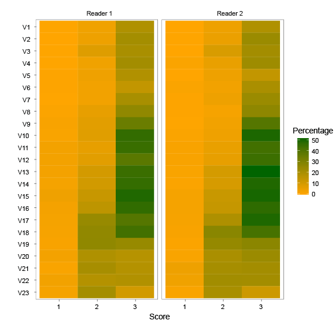Session Information
Session Type: ACR Concurrent Abstract Session
Session Time: 9:00AM-10:30AM
Background/Purpose: Low dose Computed Tomography (CT) could potentially be more sensitive than radiographs in the follow up of patients with axial spondyloarthritis (axSpA). First goal was to develop a scoring method for the spine and test its inter-reader variability.
Methods: Patients (pts) of the Sensitive Imaging of Axial Spondyloarthritis (SIAS) cohort fulfilled the modified New York (mNY) criteria and had at least 1 syndesmophyte in cervical or lumbar spine on radiographs. Baseline and 2 years follow up CT scans were performed. Syndesmophytes were scored in the coronal and sagittal planes for all ÔcornersÕ per view, thus scoring 8 ÒquadrantsÓ per vertebral unit (VU). Syndesmophytes were scored as absent (score 0), <50% of the intervertebral disc height (IVDH) (1), ³50% of the IVDH but no bridging (2) or as Òbridging the IDVHÓ (3). Score range 0-552. Two readers, blinded for clinical and laboratory information as well as time order, scored the 2 CT scans per patient. Scores of the 2 readers were compared using heatmaps. Inter-reader variability was assessed by (two-way average) intercorrelation coefficient (ICC) and smallest detectable change (SDC) analysis for the whole spine and per segment.
Results: In total, 58 pts (47 male, mean age 50.4) were included. The heatmap presents the similarity of baseline and change scores per reader per VU. Table 1 shows that both readers use almost the entire possible range, pick up a similar magnitude of change and have high ICCs. Most change is present in the thoracic spine. A change ³SDC is seen in 33.9% of the patients.
Conclusion: A fine-grained scoring system for CT spine was developed. Scoring syndesmophytes with good accuracy on CT images was feasible, picking up changes over a 2-year period in a high percentage of patients, especially in the thoracic spine, which is insufficiently visible on radiographs. Table 1 – Smallest detectable change (SDC) and inter-reader variability between readers on timepoint 1, timepoint 2 and for the difference between the timepoints (syndesmophyte growth).
| Segment (max score) | Timepoint | Median and range reader 1 | Median and range reader 2 | SDC (inter-reader) | No. of patients with growth ³SDC (%) (n=58) | ICC |
| Whole spine (552) | Timepoint 1 | 144 (16 – 428) | 135 (6 – 447) | 0.99 (0.94 – 1.00) | ||
| Timepoint 2 | 157 (18 – 428) | 146 (8 – 461) | 0.98 (0.92 – 0.99) | |||
| Change score | 9 (-11 – 96) | 8 (-6 – 93) | 12.4 | 19 (32.8) | 0.75 (0.49 – 0.88) | |
| Cervical (144) | Timepoint 1 | 8 (0 – 140) | 8 (0 – 128) | 0.96 (0.92 – 0.98) | ||
| Timepoint 2 | 8 (0 – 140) | 8 (0 – 128) | 0.98 (0.95 – 0.99) | |||
| Change score | 0 (-12 – 38) | 0 (-9 – 38) | 5.41 | 9 (15.6) | 0.85 (0.75 – 0.91) | |
| Thoracic (264) | Timepoint 1 | 84 (2 – 250) | 72 (0 – 264) | 0.97 (0.92 – 0.99) | ||
| Timepoint 2 | 93 (2 – 256) | 81 (0 – 264) | 0.97 (0.85 – 0.99) | |||
| Change score | 6 (-6 – 94) | 6 (-12 – 93) | 12.4 | 15 (25.9) | 0.85 (0.75 – 0.92) | |
| Lumbar (144) | Timepoint 1 | 32 (0 – 140) | 36 (0 – 140) | 0.91 (0.79 – 0.96) | ||
| Timepoint 2 | 34 (0 – 144) | 39 (0 – 144) | 0.99 (0.98 – 1.00) | |||
| Change score | 2 (-10 – 14) | 1 (-4 – 12) | 4.51 | 14 (24.1) | 0.56 (0.26 – 0.73) |

Distribution of syndesmophytes is similar between the two readers on both time points (vertebral unit level on the y-axis). Ankylosis (score 3) is most prevalent in the thoracic spine, and syndesmophytes in general are least prevalent in the cervical spine.
To cite this abstract in AMA style:
de Bruin F, van den Berg R, Baraliakos X, Reijnierse M, van der Heijde D. Scoring Syndesmophytes on CT Spine Images of Patients with Radiographic Axial Spondyloarthritis from the Sensitive Imaging of Axial Spondyloarthritis (SIAS) Cohort [abstract]. Arthritis Rheumatol. 2016; 68 (suppl 10). https://acrabstracts.org/abstract/scoring-syndesmophytes-on-ct-spine-images-of-patients-with-radiographic-axial-spondyloarthritis-from-the-sensitive-imaging-of-axial-spondyloarthritis-sias-cohort/. Accessed .« Back to 2016 ACR/ARHP Annual Meeting
ACR Meeting Abstracts - https://acrabstracts.org/abstract/scoring-syndesmophytes-on-ct-spine-images-of-patients-with-radiographic-axial-spondyloarthritis-from-the-sensitive-imaging-of-axial-spondyloarthritis-sias-cohort/

